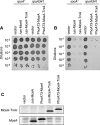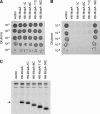Bactericidal activity of both secreted and nonsecreted microcin E492 requires the mannose permease
- PMID: 17015644
- PMCID: PMC1636244
- DOI: 10.1128/JB.00688-06
Bactericidal activity of both secreted and nonsecreted microcin E492 requires the mannose permease
Abstract
Microcin E492 (MccE492) is a bactericidal protein secreted by Klebsiella pneumoniae that is active against various species of Enterobacteriaceae. Interaction of MccE492 with target cells leads to the depolarization and permeabilization of their inner membranes. Several MccE492-specific proteins are required for the maturation and secretion of active MccE492. Surprisingly, the expression of only MceA, the polypeptide backbone of MccE492, is shown here to be toxic by itself. We refer to this phenomenon as endogenous MceA bactericidal activity to differentiate it from the action of extracellularly secreted MccE492. The toxicity of endogenous MceA is enhanced by an efficient targeting to the inner membrane. However, a periplasmic intermediate state is not required for MceA toxicity. Indeed, endogenous MceA remains fully active when it is fused to thioredoxin-1, a fast-folding protein that promotes retention of the C terminus of MceA in the cytoplasm. The C-terminal domain of MccE492 is required only for delivery from the extracellular environment to the periplasm, and it is not required for inner membrane damage. A common component is absolutely essential for the bactericidal activity of both endogenous MceA and extracellular MccE492. Indeed, toxicity is strictly dependent on the presence of ManYZ, an inner membrane protein complex involved in mannose uptake. Based on these findings, we propose a new model for cell entry, inner membrane insertion, and toxic activity of MccE492.
Figures








Comment in
-
The mannose transporter complex: an open door for the macromolecular invasion of bacteria.J Bacteriol. 2006 Oct;188(20):7036-8. doi: 10.1128/JB.01074-06. J Bacteriol. 2006. PMID: 17015642 Free PMC article. No abstract available.
Similar articles
-
The polypeptide core of Microcin E492 stably associates with the mannose permease and interferes with mannose metabolism.Res Microbiol. 2010 Oct;161(8):706-10. doi: 10.1016/j.resmic.2010.07.003. Epub 2010 Jul 30. Res Microbiol. 2010. PMID: 20674740
-
Microcin E492 antibacterial activity: evidence for a TonB-dependent inner membrane permeabilization on Escherichia coli.Mol Microbiol. 2003 Aug;49(4):1031-41. doi: 10.1046/j.1365-2958.2003.03610.x. Mol Microbiol. 2003. PMID: 12890026
-
Parasitism of iron-siderophore receptors of Escherichia coli by the siderophore-peptide microcin E492m and its unmodified counterpart.Biometals. 2006 Apr;19(2):181-91. doi: 10.1007/s10534-005-4452-9. Biometals. 2006. PMID: 16718603 Review.
-
Investigations of the MceIJ-catalyzed posttranslational modification of the microcin E492 C-terminus: linkage of ribosomal and nonribosomal peptides to form "trojan horse" antibiotics.Biochemistry. 2008 Sep 2;47(35):9289-99. doi: 10.1021/bi800826j. Epub 2008 Aug 9. Biochemistry. 2008. PMID: 18690711
-
Microcins in action: amazing defence strategies of Enterobacteria.Biochem Soc Trans. 2012 Dec 1;40(6):1456-62. doi: 10.1042/BST20120183. Biochem Soc Trans. 2012. PMID: 23176498 Review.
Cited by
-
Bacteriocin as weapons in the marine animal-associated bacteria warfare: inventory and potential applications as an aquaculture probiotic.Mar Drugs. 2010 Apr 4;8(4):1153-77. doi: 10.3390/md8041153. Mar Drugs. 2010. PMID: 20479972 Free PMC article. Review.
-
Novel class IIb microcins show activity against Gram-negative ESKAPE and plant pathogens.Elife. 2024 Dec 11;13:RP102912. doi: 10.7554/eLife.102912. Elife. 2024. PMID: 39660611 Free PMC article.
-
How nature morphs peptide scaffolds into antibiotics.Chembiochem. 2009 Jan 5;10(1):34-53. doi: 10.1002/cbic.200800438. Chembiochem. 2009. PMID: 19058272 Free PMC article. Review.
-
Contact-dependent growth inhibition (CDI) systems deploy a large family of polymorphic ionophoric toxins for inter-bacterial competition.PLoS Genet. 2024 Nov 26;20(11):e1011494. doi: 10.1371/journal.pgen.1011494. eCollection 2024 Nov. PLoS Genet. 2024. PMID: 39591464 Free PMC article.
-
Mechanisms of action of ribosomally synthesized and posttranslationally modified peptides (RiPPs).J Ind Microbiol Biotechnol. 2021 Jun 4;48(3-4):kuab005. doi: 10.1093/jimb/kuab005. J Ind Microbiol Biotechnol. 2021. PMID: 33928382 Free PMC article. Review.
References
-
- Belin, D., L. M. Guzman, S. Bost, M. Konakova, F. Silva, and J. Beckwith. 2004. Functional activity of eukaryotic signal sequences in Escherichia coli: the ovalbumin family of serine protease inhibitors. J. Mol. Biol. 335:437-453. - PubMed
-
- Bieler, S., L. Estrada, R. Lagos, M. Baeza, J. Castilla, and C. Soto. 2005. Amyloid formation modulates the biological activity of a bacterial protein. J. Biol. Chem. 280:26880-26885. - PubMed
-
- Blattner, F. R., G. Plunkett III, C. A. Bloch, N. T. Perna, V. Burland, M. Riley, J. Collado-Vides, J. D. Glasner, C. K. Rode, G. F. Mayhew, J. Gregor, N. W. Davis, H. A. Kirkpatrick, M. A. Goeden, D. J. Rose, B. Mau, and Y. Shao. 1997. The complete genome sequence of Escherichia coli K-12. Science 277:1453-1474. - PubMed
-
- Braun, V., S. I. Patzer, and K. Hantke. 2002. Ton-dependent colicins and microcins: modular design and evolution. Biochimie 84:365-380. - PubMed
-
- Brundage, L., J. P. Hendrick, E. Schiebel, A. J. Driessen, and W. Wickner. 1990. The purified E. coli integral membrane protein SecY/E is sufficient for reconstitution of SecA-dependent precursor protein translocation. Cell 62:649-657. - PubMed
Publication types
MeSH terms
Substances
LinkOut - more resources
Full Text Sources
Other Literature Sources

